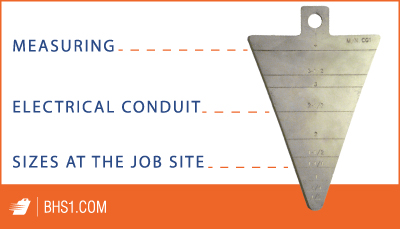We use cookies to make your experience better. To comply with the new e-Privacy directive, we need to ask for your consent to set the cookies. Learn more.
Measuring Electrical Conduit Sizes at the Job Site
For electricians, pulling cable is only half the job. Before they can even begin installing the cabling, they have to create vast networks of electrical conduit.
Electricians typically run multiple cables through a single raceway, so it's vital that they know how much space is available inside the duct. That isn't always apparent at a glance.
The trade sizes of rigid metal electrical conduit don't always correspond exactly to actual inside diameter. Even worse, bundles of conduit can arrive on-site unlabeled, and it isn't easy to tell the difference between 1.25- and 1.5-inch conduit with the naked eye.
For instance, according to online resource the Engineering ToolBox:
-
0.5-inch metal conduit actually has an inside diameter of 0.622 inches.
-
The inside diameter of 0.75-inch rigid metal conduit is 0.824 inches. (Note that this is typically the smallest tubing recommended for raceway in homes and industrial buildings, according to the Steel Tube Institute.)
-
A conduit trade size of 1 inch has an actual inner diameter of 1.049 inches.
-
2-inch lengths typically have an inside diameter of 2.067 inches.
And so on. However, these specifications only apply to rigid metal conduit (RMC), which is the thickest metal raceway available. While that's great for mechanical protection, the thick walls and the zinc coating on galvanized steel conduit diminish available inner space.
The same trade size may be listed for a length of RMC, a piece of intermediate metal conduit (IMC), and electrical metallic tubing (EMT). Within each product, though, clearance differs slightly. Besides, products from different manufacturers may have subtle differences, even from one section of conduit to the next. Any variation in inner diameter can cause problems during joining, or when planning how many cables you can pull within a single run.
So, given all of these factors, what's the ideal way to measure a length of raceway before installing it?

These simple triangular measuring tools accurately gauge the inner wall-to-wall diameter of any piece of conduit. While the all-steel Electrical Conduit Gauge from BHS was designed to measure the inner diameter of steel and aluminum conduit, when used correctly it's just as effective for PVC and flexible conduit.
The Electrical Conduit Gauge accurately measures tubing from 0.5 inches to 4 inches in diameter. Measurements are laser-engraved into corrosion resistant stainless steel, providing clear trade size recognition for conduit even in harsh industrial environments, without fear of obscuring markings with decades of hard use. There's even a handle 0.5-inch hole at the base for simple storage by hanging.
Throw an Electrical Conduit Gauge into your kit alongside your conduit cutter and a bending tool, and you're ready to install complex runs wherever the job requires it.
References:
"Conduits Sizes." EngineeringToolBox. The Engineering ToolBox, n.d. Web. 22 June 2017.
http://www.ecmag.com/section/your-business/cool-tools-conduit-benders
Eby, Mike. "The Basics of Steel Conduit." ECMWeb. Penton, 1 Aug. 2004. Web. 22 June, 2017.
"Guidelines for Installing Steel Conduit/Tubing." SteelTubeInstitute. Steel Tube Institute of North America, n.d. PDF. 22 June 2017.
